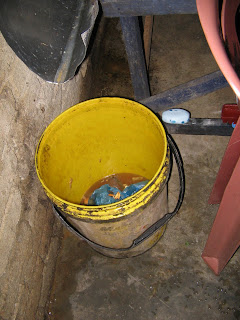Actually, today our programme is outdoor activity. According to our schedule, we will be having short briefing on Bekalan Air dan Keselamatan Alam Sekitar(BAKAS). First we went to Pejabat Kesihatan Daerah Sik. The PPKP unit was in charge to guide us to Kampung Sungai Senam.


Then, to proceed further to top of the hill, we get into one jeep. This is definitely a different experience for all of us. We travel through the jeep along the way to hill. The jeep stopped halfway, and we experienced hiking to continue our journey to the place where water is stored.

The place is called Gravity Feed System (GFT). The GFT is built in 1987, but just functioned for 2 years and has not been used after that until now. Currently, the village people are planning to reconstruct the GFT. The source is from the hill water and supplying to village people.


Together with us and the PPKP, many village men followed us to the hill. After reached the hill, the Tok Imam of the village gave us a short briefing on the GFT, how it is managed and the reconstruction planning. Then, the PPKP showed us the method of checking water conductivity, oxygen content, pH and turbidity. The range of normal values for conductivity is <100, for oxygen content (by oxygen meter) is 1-1000, for pH is 5-7 and for turbidity is 1-1000. This is to ensure that the water is safe to drink by the village people.



After that, we had breakfast and drink prepared by the village people, which is not new thing for us in Sik. The village people are very friendly and humble as well.


This is our beloved captain, Mr.Nitiyanantham.

All of a sudden, one guy jumped into the water to open the pipe, and to allow the flow of the water. Photos below showing the chain of reaction of that incident.





After that, we came down the hill by the same jeep, and then by car back to Kampung Sungai Senam. Then, we went to Pejabat Kesihatan Daerah (PKD) Sik. We said goodbye to the people in PKD and left to Sungai Petani.



At the end of the day, we planned a get-together, so that we can share our memories in this past two weeks in Sik. So, we went for dinner together in Wandly Siang. Eventhough we were tired, we spent a lot of time tonight chit-chating with each other. We were very happy that we could work together. Through this posting, we learnt a lot about team work and hope we will get a chance to team up again in future. Goodbye and meet again next time!




















































